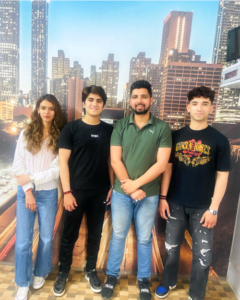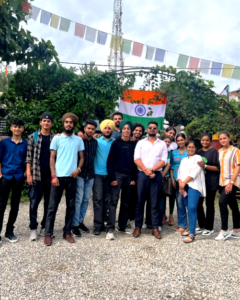Seaweed For Human Consumption
Seaweeds are algae that live in the sea or in brackish water. Scientists often call them ‘benthic marine algae’, which just means ‘attached algae that live in the sea’. Seaweeds come in three basic colours: red, green, and brown: dulse is the red seaweed; sea lettuce is amongst the green algae; and the brown is a wrack. Red and brown algae are almost exclusively marine, whilst green algae are also common in freshwater and in terrestrial situations. Many of these algae are very ancient organisms, and although lumped together as ‘algae’ are not actually closely related, having representatives in four of the five kingdoms of organisms. There are about 10,500 species of seaweeds, of which 6,500 are red algae (Rhodophyta).
The trend today is to refer to marine algae used as food as ‘sea-vegetables’. The main species used in Ireland at present are dulse, carrageen moss, and various kelps and wracks. Dulse – also known as dillisk in a number of areas – is a red alga that is eaten on both sides of the North Atlantic. Generally only eaten in Ireland after it has been dried, it is frequently sold in small packets, most commonly in the west and north. About 16 tonnes are used in Ireland at present; the species is also eaten in Canada, Iceland, Norway, France and Scotland. About 53 tonnes of carrageen moss were gathered in Ireland in 1994.
Whilst dulse and carrageen moss are worthy sea- vegetables with a history of utilisation and a small but proven market, other species also show considerable promise. Our kelp resources are considerably under-utilised. All of the kelp species are edible but Laminaria saccharina is probably the most palatable as it has a somewhat sweet taste, probably due to its high levels of mannitol, and it also cooks better.
Two other brown algae with potential as food are currently under investigation by us: Himanthalia elongata, known in some places as thongweed, and Alaria esculenta, also known as dabberlocks or murlins. Himanthalia is eaten in France after drying or pickling (‘Spaghettis de mer’), and plants are sold in Ireland dried. After soaking in water it makes a surprisingly fine accompaniment to a mixed salad; it does not have the strong seaweedy taste that some dislike. With the aid of a basic research grant from Forbairt, the Irish research and development body, we are examining the growth and life cycle of populations of this species on the west coast. Plants are easy to collect but must be dried quickly and packaged well to preserve their excellent taste and mouth feel.
Alaria is a large, kelp-like brown alga that grows on exposed shores. In Ireland, plants grow to considerable sizes, being found up to 6m in length in some areas, but these are dwarfed by some Pacific species that may grow to 18m in length and to 2m in width. With Marine Research Measure funding, a study of the possibility of developing fast-growing hybrids of this species by crossing species from the Atlantic and Pacific is being carried out. We have growing in culture isolates of A. esculenta from Ireland, Scotland, France, Norway, and Atlantic Canada and other species from British Columbia and Japan. Species of this genus are ideal for cross-breeding studies as the males and females are tiny filamentous plants that are relatively easy to grow and propagate in culture under red light which stimulates reproduction in our growth rooms. Male and female reproductive structures occur on different plants so that we can put plants from one country in with those from another to see if they are sexually compatible.
To date, we have obtained interesting results with A. praelonga, a large species from japan that co-operates sexually with A. esculenta from the Aran Islands and other Irish sites. The resulting Irish/japanese progeny are grown initially in sample bottles agitated on a small shaker and their growth rates compared with plants that have resulted from self crosses. Preliminary results are very encouraging, with hybrid plants showing relatively high growth rates. We hope by this method to obtain sterile hybrids that will not reproduce in the wild so that we can introduce foreign genetic material without the fear that some sort of a traffic will be introduced that will take over the west coast of Ireland.
While studies of these two food species are very promising, we must bear in mind that the market for such sea-vegetables is very small and needs development and investment. Nutritionally, sea-vegetables are as good as any land-vegetable and are superior in their vitamin, trace element and even protein content. The increase in catholic food tastes in Europe should see greater utilisation of sea-vegetables in the next 20 years.
Questions 1-5
Classify the following features as characterizing
A brown algae
B green algae
C red algae
D brown and red algae
Write correct letter A, B, C or D in boxes 1-5 on your answer sheet.
1 are being investigated as possible food sources.
2 are now called sea-vegetables.
3 make up more than half of all seaweed species.
4 are found on land and in freshwater.
5 are nearly all marine.
Questions 6-9
Complete the table below. Choose NO MORE THAN THREE WORDS from the passage.
| Types of brown algae | Himanthalia elongate | Alaria esculenta |
|---|---|---|
| Potential | food | food |
| Common name | thongweed | dabberlocks or (6)………………. |
| Research funded | with a (7)……………….from Fortbairt | by marine research measure |
| Purpose | to examine growth and life cycle populations | creation of fast growing (8)…………….. |
| Advantage | easy to collect | just right for (9)………………. |
Questions 10-13
Answer the questions below. Choose NO MORE THAN THREE WORDS from the passage for each answer.
10 What does the red light in the growth rooms do?
11 What are initial growth rates shown to be?
12 What does the sea-vegetable market need?
13 What increasingly should lead to greater consumption of sea-vegetables?
Designing And Shipping After The Restriction Of Hazardous Substances (RoHS) Directive
1 Almost two months after the European Union’s ban on the use of six environmentally unfriendly materials went into effect, designers have clear evidence that failure to meet the Restriction of Hazardous Substances (RoHS) directive means lost sales. Palm Inc. recently announced that its Treo 650 smart phone is no longer being shipped to Europe, since it doesn’t meet RoHS requirements. And several Apple Computer Inc. products will not be sold in Europe for the same reason.
2 The EU directive, which took effect on 1st July, covers lead, mercury, cadmium, hexavalent chromium, polybrominated biphenyls and polybrominated diphenyl ethers. Electronics vendors worldwide are working to eliminate those substances from nearly all new products developed for the European market, while also adapting their manufacturing processes to a lead (Pb)-free environment.
3 But that is only the beginning. Other countries, including China, Taiwan and South Korea, and certain U.S. states are creating their own “green” or RoHS-like legislation. That means RoHS compliance must become an integral part of a designer’s development process, with RoHS checks at each step: concept, development, prototype, first builds and volume production.
4 Major companies will run the gamut from finding component databases of qualified green components to taking due care to prove compliance and developing processes that allow for the higher-temperature requirements of Pb-free manufacturing. And for designers, those are just the tip of the iceberg. A host of technical and reliability issues remain to be sorted out in Pb-free board processing and soldering.
5 What it comes down to is what Ken Stanvick, senior vice president at Design Chain Associates, calls a lack of ‘tribal knowledge’ on design RoHS- compliant systems. ‘We had a great tribal knowledge when it came to dealing with leaded systems, but we haven’t built up that same amount of knowledge for Pb-free,’ he said. ‘Every problem will be blamed on Pb-free until it’s been worked out. We need to figure out tests that replicate more of the environment and different stresses that we’re going to see in this new system.’
6 Manny Marcano, president and CEO of EMA Design Automation Inc. (Rochester, N.Y.), cited the impact of parts obsolescence, including the need to redesign older products and the resultant emphasis on component engineering at the expense of conceptual design. A key challenge is identifying RoHS design specifications as early as possible in the design process, he said.
7 But even before they get to that point, designers must understand whether they are designing a fully compliant product or one that’s subject to some exemptions, said Robert Chinn, director for consultant firm PRTM (Mountain View, Calif.). This affects their design parameters,’ he said. ‘Previously, they looked at components based on size, performance, electrical parameters, features and functionality. Now they have to add on a new constraint, revolving around environmental compliance: Is it RoHS 6-compliant or is it RoHS 5-compliant?’ (RoHS 6 components eliminate all six of the banned substances, while RoHS 5 models, because of exemptions, still contain lead.)
8 If designers do not take RoHS seriously, any country that can prove a product does not comply can levy fines against the vendor. That can cost market share, Marcano said, since noncompliant companies become noncompetitive. And then, not being prepared can mean belatedly diverting resources to RoHS compliance, causing missed market opportunities.
9 But many industry observers believe smaller and medium-size companies will continue to be complacent about the RoHS transition until some major company is cited for non-compliance. ‘When that happens, there will be an earthquake throughout the industry, and it will wake up every design engineer,’ said Steve Schultz, director of strategic planning and communications at Avnet Logistics and program manager for the distributor’s compliance efforts for RoHS in the Americas.
10 ‘The product developer’s RoHS concerns center on the fear of lost revenue – from a product ban, a customer who demands a RoHS-compliant product that the company doesn’t have, or competition’, said Harvey Stone, managing director for consultancy GoodBye Chain Group (Colorado Springs, Colo.). ‘With price, quality and service being relatively equal, a savvy customer is going to choose a RoHS-compliant product,’ he said.
11 Meanwhile, designers are looking over their shoulders at several other – and potentially stricter – environmental regulations in the pipeline. These include the EU’s Registration, Evaluation and Authorization of Chemicals legislation, which could restrict the use of thousands of chemicals, and its Energy¬using Products (EuP) directive, which will initially target energy-efficiency requirements.
Questions 14-17
Look at the following people and the list of statements below. Match each person with the correct statement.
Write the correct letter A-G in boxes 14-17 on your answer sheet.
14 Manny Marcano
15 Harvey Stone
16 Steve Shultz
17 Ken Stanvick
List of Statements
A believes that the EU directive requires no action
B claims that old products need to be redesigned
C claims that customers will want a RoHS compliant product
D states that many products will be RoHS exempt
E is involved in planning and communications
F predicts that design engineers will like RoHS
G claims that more knowledge about Pb-free systems is needed
Questions 18-24
Complete the summary using the list of words A-P below. Write the correct letter A-P in boxes 18-24 on your answer sheet.
The EU has banned the use of six materials that are (18)……………………….to the environment. This means that if designers do not meet the Restriction of Hazardous Substances (RoHS) directive, sales will (19)……………………….Similar legislation is being put together around the world, which indicates that RoHS compliance needs to become a (20)……………………….part of a designer’s development process. RoHS checks at every step from concept to mass production is also a necessity. But (21)…………………………technical and reliability problems remain to be (22)……………………. Previously, the performance etc. of components were (23)…………………………but now a new (24)………………………needs to be taken into account: environmental compliance.
| A requirement | B friendly | C hostile | D increase |
| E big | F basic | G insignificant | H numerous |
| I variety | J decline | K solved | L important |
| M idea | N small | O reconginzed | P need |
Questions 25-27
Do the following statements agree with the information in Reading Passage 2?
In boxes 25-27 on your answer sheet write
TRUE if the statement agrees with the information
FALSE if the statement contradicts the information
NOT GIVEN if there is no information about the statement
25 Countries can impose fines on the sellers of products that do not comply with RoHS.
26 Smaller companies are taking the changeover to RoHS seriously.
27 The Energy-using directive will be introduced in the very near future.
Seeing The Future In With Video Conferencing
A Video-conferencing (or Video tele-conferencing-VTC) as a means of communication intra- and inter-business has essentially been possible since the dawn of television. But the early systems, first demonstrated in 1968, were in fact so prohibitively expensive and of such poor picture quality that they were not viable applications for general public use.
B However, in the 1980s, digital telephone networks like ISDN began to proliferate, so that by the 1990s the decrease in cost brought the equipment necessary for video-conferencing within the reach of the masses. The 1990s also saw the arrival of IP (Internet Protocol) based video-conferencing with more efficient video compression technologies being introduced, thus permitting desktop, or personal computer (PC)-based video-conferencing. VTC had come on the scene in a big way as free services, web plugins and software, such as NetMeeting, and MSN Messenger, Skype and others brought cheap, albeit low- quality, VTC to the public at large.
C Video-conferencing has been disparaged for the lack of eye-contact that can affect the efficacy of the medium and for the fact that participants can be camera conscious. But these obstacles are not insurmountable. The size of modern televisions along with the vast improvement in picture quality as a result of the arrival of the digital age has enhanced the potential of the latest video-conferencing equipment, going somewhat towards solving the former problem. Early studies by Alphonse Chapanis found that the addition of video hindered rather than improved communication. However, as with video and sound recording of meetings, interviews etc. awareness of the presence of the technology diminishes with time to the point that its presence is not felt. A further drawback common to all technology is the ever present possibility of technical hitches. But in the end video-conferencing is no different from any electronic device like a PC or a telephone and so in time, any problems will be ironed out.
D Conferencing by video has enhanced the performance of different organizations through its efficiency and effectiveness, saving both time and money for businesses and, in this carbon-conscious age, by the reduction in the environmental cost of business travel from one corner of the world to another. These apart, video-conferencing has an immediacy that is difficult to challenge. It is now essential in any work situation where organizations with employees on different sites or in different parts of the globe can contact each other rapidly. Like a telephone line permanently connected it is easy to dial up a colleague in seconds anywhere in the world.
E And what about the equipment? The equipment for video-conferencing is relatively straightforward to use. It has, in fact, been commonplace in the news media for a number of years as corporations have broadcast live from the back of a truck or van in news hotspots around the world. Two ISDN lines are needed at each location: one for video output and the other for video input; a high quality camera with omnidirectional microphones or microphones which can be hand-held, clipped on or central are required; and for data transfer a LAN is also needed. And, of course, a television screen at each end is essential.
F The potential use of video-conferencing in the educational field has yet to be fully exploited. In this day and age when academic institutions are supposed to be more revenue conscious and much more flexible, video-conferencing could be employed to bring business into the educational field and vice versa. The system can also be used to take expertise anywhere in the world. It is no longer necessary for experts to travel vast distances for conferences or to teach. In certain areas, say remote islands like the Outer Hebrides in Scotland or the Cape Verde Islands off West Africa, where it may be difficult to find teachers in specialist subjects like languages, video-conferencing is a perfect way to bring education within the reach of everyone. Video-conferencing is certainly not a panacea for every problem, not an end in itself, but a useful tool that can complement rather than supplant existing teaching methods.
G Like the electronic or smart whiteboard, whose introduction in the classroom has met with resistance, video-conferencing may take some time to become mainstream, if ever. But, perhaps with the mounting concern about our carbon footprint, the environment will ultimately be the biggest spur. A sobering thought is whether classrooms and offices of the future will consist solely of TV screens.
Questions 28-33
Reading Passage 3 has seven paragraphs A-G. Choose the correct heading for paragraphs A and C-G.
List of Headings
i Some criticisms of video-conferencing
ii The future of conferencing by video
iii The transmission of education to remote areas
iv The first stages of video-conferencing
v The necessity of having two TVs
vi How video-conferencing can benefit organizations
vii How video-conferencing became more accessible to the general public
viii The various pieces of equipment needed
ix The lack of exploitation of video-conferencing in education
Example: Paragraph B Answer vii
28 Paragraph A
29 Paragraph C
30 Paragraph D
31 Paragraph E
32 Paragraph F
33 Paragraph G
Questions 34-36
Choose the correct letter A, B, C or D.
34 Video-conferencing was not common initially because of
A the cost and poor image quality
B poor advertising and marketing
C the lack of skilled technicians
D constant electronic failures
35 Video-conferencing became more practical on personal computers once
A the Internet became more widespread
B the picture quality became perfect
C the software became free for the general public
D video compression technology worked better
36 Video-conferencing has been attacked for
A several problems that cannot be solved
B the lack of large TV screens
C there not being direct eye contact
D the failure of new digital technology
Questions 37-39
Choose THREE letters A-F.
Which THREE of the following statements are true of video-conferencing?
A It is cost-effective for businesses to use.
B Operating VC equipment is not complicated.
C It will solve many problems in the classroom.
D More people now have the necessary skills to use video-conferencing.
E Modern equipment rarely breaks down.
F People in remote areas can have expertise taken to them.
Question 40
Choose the correct letter A, B, C or D.
40 The writer concludes that the success of video-conferencing in the classroom
A is less likely than that of the whiteboard
B will certainly be short-lived
C may be linked to many unknown factors
D may finally depend on the environment








